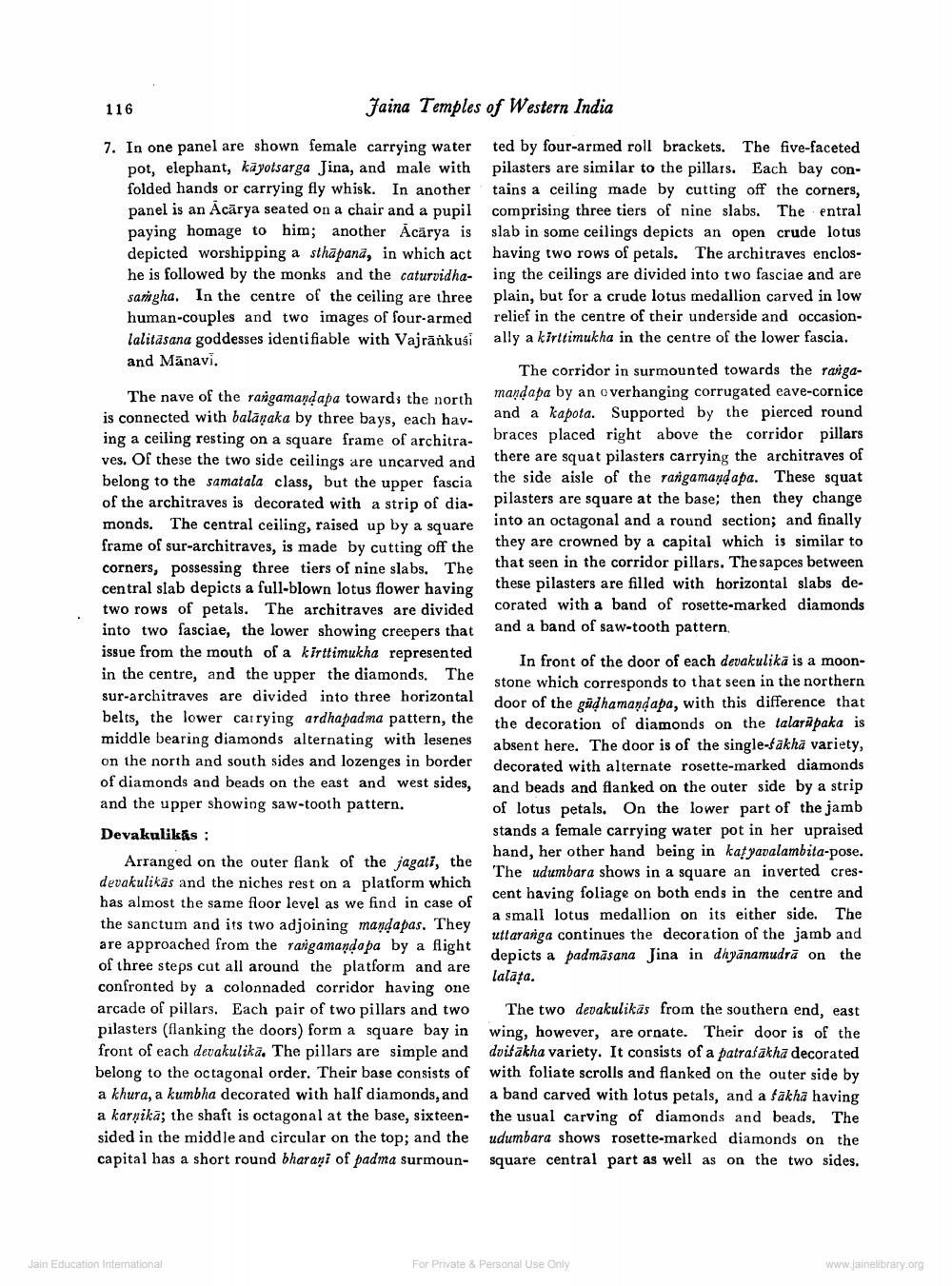________________
116
Faina Temples of Western India
7. In one panel are shown female carrying water ted by four-armed roll brackets. The five-faceted
pot, elephant, kāyotsarga Jina, and male with pilasters are similar to the pillars. Each bay confolded hands or carrying fly whisk. In another tains a ceiling made by cutting off the corners, panel is an Ācārya seated on a chair and a pupil comprising three tiers of nine slabs. The entral paying homage to him; another Acārya is slab in some ceilings depicts an open crude lotus depicted worshipping a sthapanā, in which act having two rows of petals. The architraves encloshe is followed by the monks and the caturvidha- ing the ceilings are divided into two fasciae and are samgha. In the centre of the ceiling are three plain, but for a crude lotus medallion carved in low human-couples and two images of four-armed relief in the centre of their underside and occasionlalitasana goddesses identifiable with Vajränkusi ally a kirttimukha in the centre of the lower fascia. and Mānavi.
The corridor in surmounted towards the rangaThe nave of the rangamandapa towards the north
mandapa by an overhanging corrugated eave-cornice is connected with balāņaka by three bays, each hav
and a kapota. Supported by the pierced round ing a ceiling resting on a square frame of architra
braces placed right above the corridor pillars ves. Of these the two side ceilings are uncarved and
there are squat pilasters carrying the architraves of belong to the samatala class, but the upper fascia the side aisle of the rangamandapa. These squat of the architraves is decorated with a strip of dia- pilasters are square at the base; then they change monds. The central ceiling, raised up by a square
into an octagonal and a round section; and finally frame of sur-architraves, is made by cutting off the they are crowned by a capital which is similar to corners, possessing three tiers of nine slabs. The
that seen in the corridor pillars. The sapces between central slab depicts a full-blown lotus flower having
these pilasters are filled with horizontal slabs detwo rows of petals. The architraves are divided corated with a band of rosette-marked diamonds into two fasciae, the lower showing creepers that and a bat
fasciae. the lower showing creepers that and a band of saw-tooth pattern, issue from the mouth of a kirttimukha represented
In front of the door of each devakulikā is a moonin the centre, and the upper the diamonds. The
stone which corresponds to that seen in the northern sur-architraves are divided into three horizontal
door of the güdhamandapa, with this difference that belts, the lower carrying ardhapadma pattern, the the decoration of diamonds on the talarūpaka is middle bearing diamonds alternating with lesenes
absent here. The door is of the single-fakha variety, on the north and south sides and lozenges in border
decorated with alternate rosette-marked diamonds of diamonds and beads on the east and west sides, and beads and flanked on the outer side by a strip and the upper showing saw-tooth pattern.
of lotus petals. On the lower part of the jamb Devakulikás :
stands a female carrying water pot in her upraised
hand, her other hand being in katyavalambita-pose. Arranged on the outer flank of the jagati, the
The udumbara shows in a square an inverted cresdevakulikās and the niches rest on a platform which has almost the same floor level as we find in case of
cent having foliage on both ends in the centre and
a small lotus medallion on its either side. The the sanctum and its two adjoining mandapas. They
uttaranga continues the decoration of the jamb and are approached from the targamandapa by a flight
depicts a padmasana Jina in dhyānamudrä on the of three steps cut all around the platform and are
lalata. confronted by a colonnaded corridor having one arcade of pillars. Each pair of two pillars and two The two devakulikās from the southern end, east pilasters (flanking the doors) form a square bay in wing, however, are ornate. Their door is of the front of each devakulika. The pillars are simple and dvitakha variety. It consists of a patrafakha decorated belong to the octagonal order. Their base consists of with foliate scrolls and flanked on the outer side by a khura, a kumbha decorated with half diamonds, and a band carved with lotus petals, and a fākha having a karnika; the shaft is octagonal at the base, sixteen- the usual carving of diamonds and beads. The sided in the middle and circular on the top; and the udumbara shows rosette-marked diamonds on the capital has a short round bharani of padma surmoun- square central part as well as on the two sides.
Jain Education International
For Private & Personal use only
www.jainelibrary.org




